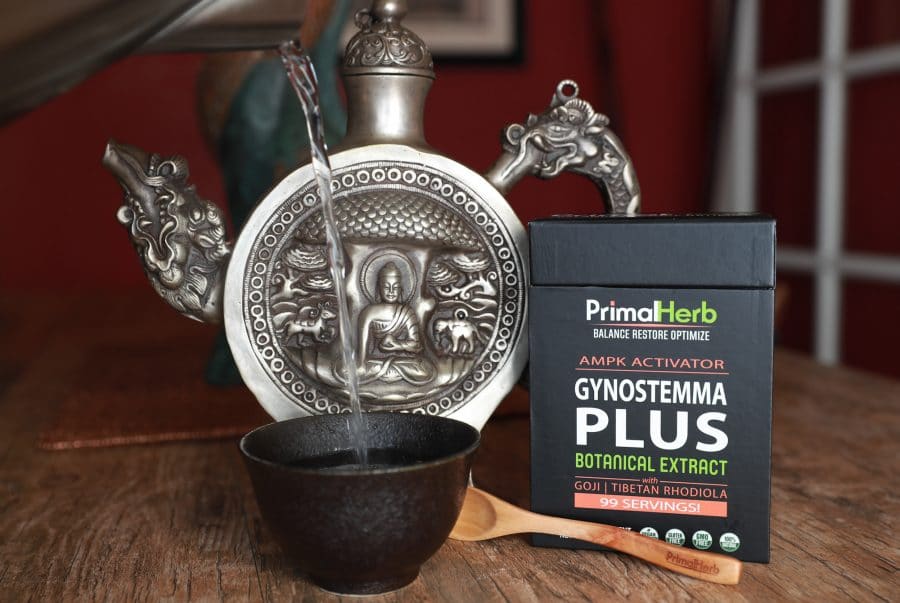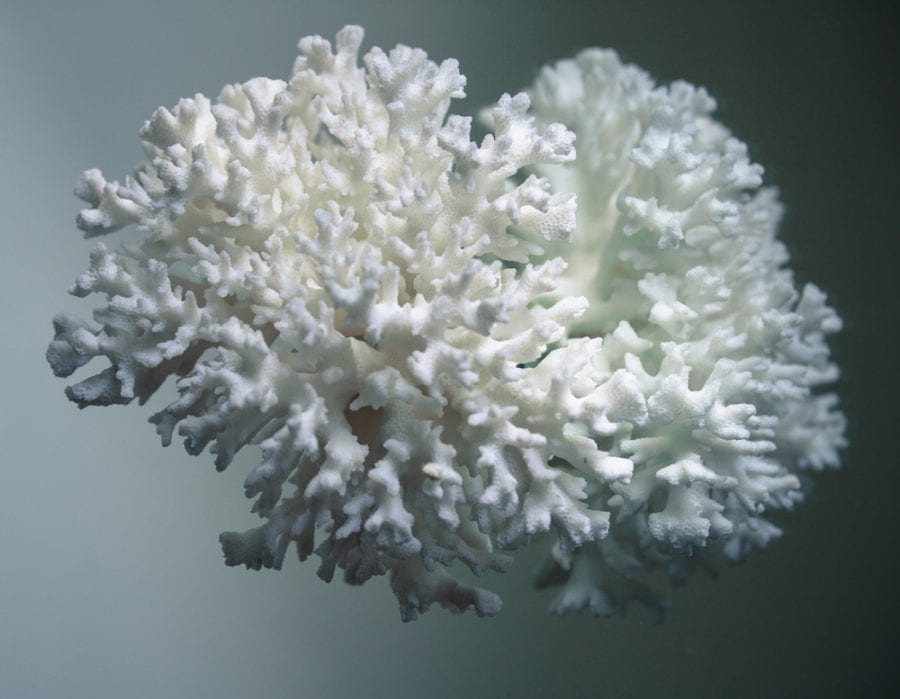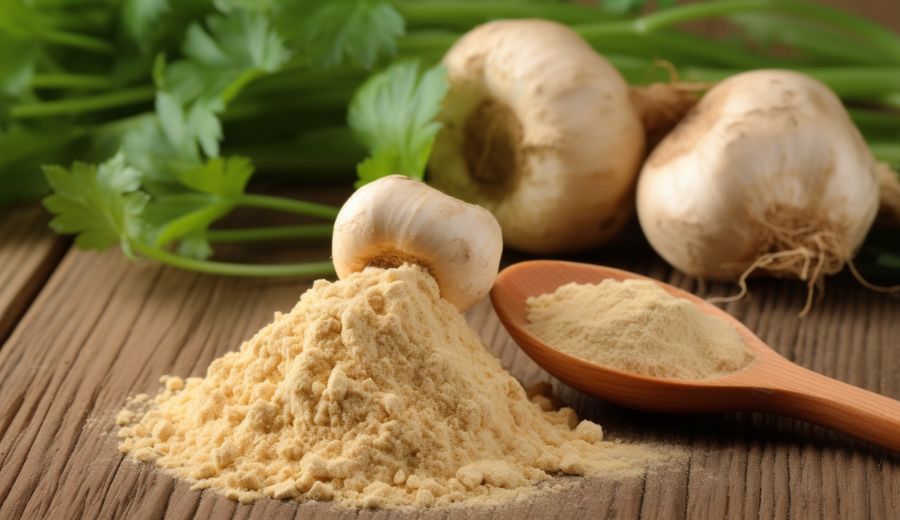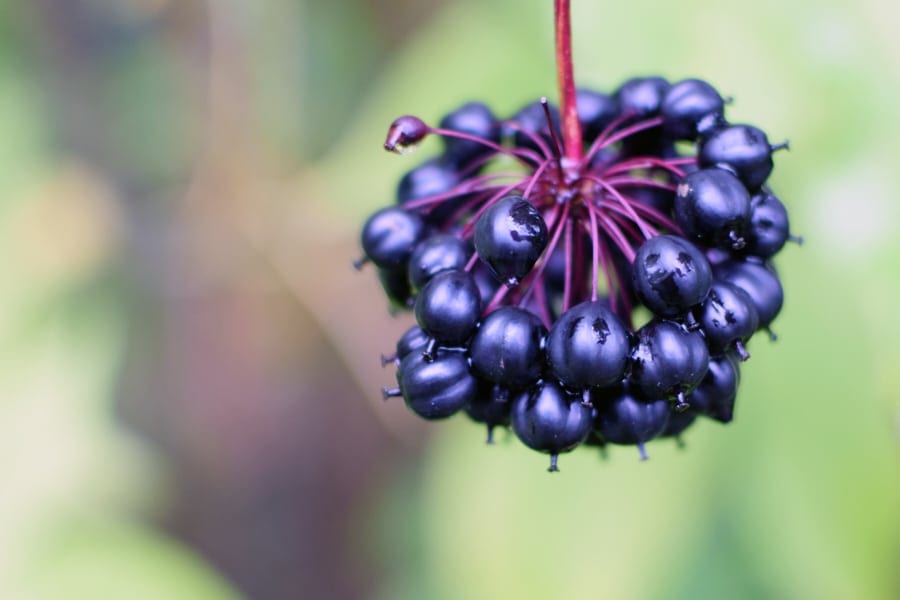Unlock the Pain-Relieving Power of Gynostemma (Jiaogulan)
Pain isn’t always simple. Pain can be acute or intense, but it can also be chronic, subtle, and life-changing.
No matter what pain may be like, it can be limiting. More frustrating are the limited ways we are given by modern medicine to deal with it, regardless of what causes it.
Step outside the mainstream and there could be natural, more holistic management approaches to be found.
Certain herbs, botanicals, and supplements have been shown by modern science—and used for thousands of years—to help manage pain, though in a different way than modern approaches.
Of all herbs currently being explored, gynostemma may be among the most promising for pain management, and for many reasons.

GYNOSTEMMA: THE HERB OF LONGEVITY
Though history and research show gynostemma (also known as jiaogulan, jiao-gu-lan, or Gynostemma pentaphyllum) to be good for pain, the herb has a more legendary and awe-inspiring story to tell about its origins.
As legends would have it, gynostemma could make people live longer.
Though this wasn’t just legend. Citizens in southern China, the region where the vine-like herb is native to, are known to take gynostemma as a daily ritual tea as part of an important cultural practice.
Average ages among the elderly in these cultures have been found to reach over 100 years old, and sometimes quite higher.
BEYOND IMMORTALITY: A GREATER ROLE TO PLAY
Gynostemma’s reputation has led it to being associated with longevity, even immortality over the years.
Of course, gynostemma can’t grant immortality—but it could offer a lot more than just better longevity and graceful aging.
The plant, which is a relative of cucumbers, has “adaptogen” qualities. This means it can help improve and protect overall body health. Part of this accounts for its longevity-boosting effects, many other benefits, but also its pain-supporting qualities.
But how effective are these benefits, really?
CAN GYNOSTEMMA HELP WITH PAIN?
Ancient healers and herbalists of old used gynostemma for helping with pain. Today, science sees great potential in it for pain, too.
Unfortunately, this doesn’t mean people can throw out meds, pain pills, or other measures to rely on this herb because Gynostemma doesn’t work like these.
On the other hand, the herb may provide the support these meds cannot.
This comes in the form of natural, nutritive, and antioxidant actions that support systems in the body related to pain over time, and thus help reduce pain in an indirect manner.
This may not sound momentous, but studies are showing this herb could make a bigger impact on pain than we know.
SCIENTIFIC REASONS GYNOSTEMMA HELPS PAIN
Gynostemma has been used by traditional healers successfully for pain management, which says a lot about its possibilities. But what does science have to say?
In summary, gynostemma may be a top holistic herb choice for pain.
Research shows it could also do this in many different ways and for many different types of pain. It could even go beyond supporting pain to support illnesses that are related to or cause pain.
Over time, this could possibly reduce pain severity and symptoms, though more research on gynostemma will ultimately be needed. In the meantime, here are the following promising benefits research has uncovered thus far.
ANTI-INFLAMMATORY
Inflammation can be one of the leading causes of pain in people, especially when it comes to chronic pain.
But there’s great news for people experiencing inflammation-caused pain: gynostemma is rich in antioxidants. One study showed this makes the herb anti-inflammatory owing to the plant antioxidant compounds known as “saponins” that it contains.
Another study (among many others) showed similar results, meaning gynostemma could help reduce chronic inflammation naturally.
Over the long term, this makes the famed longevity herb a possible supportive supplement for chronic pain connected to inflammation. This could be digestive system-related pain, muscular inflammation pain, and much more.
NEUROPROTECTIVE
When people first think of inflammation, they might imagine inflammation of tissues, muscles, or other common organs. But inflammation can affect the nerves, too.
In fact, inflammation of the nerves is often the source of most nerve pain.
Studies show gynostemma is good at targeting inflammation in the nervous system especially. As such, it can be a great choice for holistic botanical nerve pain support.
Sufferers experiencing conditions with nerve pain like fibromyalgia, autoimmune disorders (like multiple sclerosis), or nerve injuries like sciatica could benefit from a good gynostemma supplement, without going off their current medications, though more studies are needed.
MIGRAINES
In the practice of Traditional Chinese Medicine (TCM), gynostemma has long been an herbal remedy for headaches. This includes migraines, some of the toughest, most painful chronic headaches people can experience—and which can be experienced for many different reasons.
Many studies, such as this one, continue to reference this traditional and even clinical use because it has continued to be so successful over time.
Migraines can be caused by many things, though one major factor can be inflammation, which gynostemma may help with. Instead of working as a remedy, it may possibly help reduce the occurrence of migraines when used over the long-term, though more research is needed to confirm this.
MOOD AND EMOTIONAL PAIN
Gynostemma is not just good for dealing with physical pain, such as in the nerves or from inflammation.
It could also deal with more intangible forms of pain too—like in the mind and in the brain.
One study actually showed gynostemma could help anxiety caused by stress, while another study suggested it could relieve depression. It can’t yet be considered a form of relief for mood, stress, or emotional disturbances, though, in time, it may be explored as a form of relief for mood problems one day.
In the meantime, research shows the herb’s anti-inflammatory effects on neuroinflammation could be an excellent natural support for one’s mood in the interim.
PAIN-RELATED AND OTHER HEALTH BENEFITS OF GYNOSTEMMA
Gynostemma’s benefits for pain relief don’t just end there. The botanical’s effects on pain are so tied into its healing effects on other aspects of health, it can be said that it doesn’t just help with the pain—it also holistically helps with certain issues in the process, too.
As a healer, gynostemma may help take pain support to the next level.
Again, it can provide many other health benefits in the form of being holistically supportive of poor health and even certain health conditions. It can also do this in a number of ways in addition to providing pain relief, which we’ll explore below.
MENTAL HEALTH & NEUROLOGICAL DISORDERS
As many who experience mental health issues known full well, pain and discomfort are not just felt physically. They exist in the mind, brain, and nervous system as well.
Gynostemma may provide pain relief for emotional and mood disorders over the long term, though it may actually be doing this because it’s nutritively supporting those conditions in and of themselves.
As studies earlier in this article have shown, gynostemma helps neuroinflammation.
Research shows neuroinflammation is involved with clinical depression, anxiety, and other mood disorders. With that said, this southern Chinese herb of longevity could be a great natural support for anxiety, depression, and a wide range of mood disorders beyond that.
On the subject of neuroinflammation too, studies are starting to show gynostemma may be supportive of certain neurological disorders as well, particularly Parkinson’s disease. Some of these conditions (including Parkinson’s) can involve pain, discomfort, and even anxiety or depression as mood disturbances.
For this reason, the way this legendary herb works for pain in the emotional and mood realm can be outstanding. It helps neurological, nervous, and emotional health by helping with pain and beyond—though more studies will be needed to confirm their ability to support any of these in any therapeutic capacity.
URINARY PAIN
One intriguing study has shown gynostemma can act beneficially on the urinary system, and on any pain there too. In the study, the herb appeared to show the best benefits for the bladder.
In addition to pain, this makes gynostemma great for kidney health, too.
Researchers have found that it very likely does this because it is both an anti-inflammatory and antioxidant all in one. It also appears to have an additional antimicrobial effect that can help reduce the chances of getting kidney, bladder, or other urinary infections too.
Altogether, this research makes for an herb that could be great for both pain AND support of the urinary system, including for those with diabetes.
DIABETIC PAIN
Kidney or other types of urinary (such as bladder) pain can eventually become a painful struggle among those who are dealing with type 2 diabetes. For this reason, the herb’s benefit could be great for naturally helping diabetes in this regard.
But there’s more research to add on to that.
Some studies show that gynostemma can directly help type 2 diabetes, and not just the painful aspects of it. One study revealed that the vine-like plant could help increase insulin sensitivity in subjects with diabetes, which is key to helping them better control blood sugars and avoid the disease progressing.
ARTHRITIS
A painful condition in and of itself, research is also hopeful in the realm of arthritis. This can apply whether it’s rheumatoid arthritis (an inflammatory autoimmune disorder) but also osteoarthritis (OA).
Studies even point towards gynostemma as a useful potential therapeutic agent to study further for OA treatment.
In one study, compounds found in the herb (called gypenosides) appeared to affect cells in the human body that led to pain and inflammation associated with OA. It’s certainly no medication for the condition yet, but it one day could be with the help of more research.
GYNOSTEMMA MAY HELP PAINFUL SKIN ISSUES
The skin should not be overlooked as an important bodily organ. But all too often, it tends to be.
Some of the most painful conditions can happen for people with skin disorders.
These might include conditions like psoriasis, eczema, various allergies, and much more. Curiously, a 2012 study revealed that extracts of gynostemma helped conditions in the body—particularly immune and inflammation-related ones—to reduce the pain and symptoms of psoriasis, which can be a painful and uncomfortable skin problem.
It’s possible that one-day treatments for painful skin disorders could be plant-based and include healing ingredients like gynostemma, though until then, research has a lot more to discover about this traditional and potent herb.
Get Social – Like, Comment, Pin, and Share!
Recommended
Elevate Your Memory: Nature’s Best for Cognitive Boost
It can be frustrating, the way it infiltrates anything and everything in one’s routine. At first, we might not be able to put a finger on what’s going on, or even think of it as …
Deficiency to Vitality: The Role of Maca, Epimedium, Tribulus, & Goji Berry
One of the most fundamental aspects of Traditional Medicine is the concept of yin and yang. They are opposite but complementary forces that are essential in balance for optimal health. Too much or too little …
Unleashing Siberian Eleuthero: From Energy Boosts to Stress Relief & Beyond
Herbs can be powerful tools for health. Over time, research has revealed certain botanicals to have numerous benefits. Plants like schisandra, rhodiola, and he shou wu are great examples—but turning to just one herb isn’t …
- Exclusive Offers
- Product Giveaways
- Latest Research
- New Product Launches








